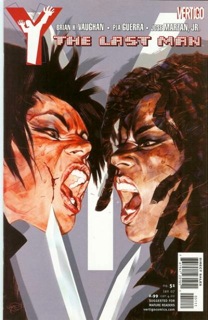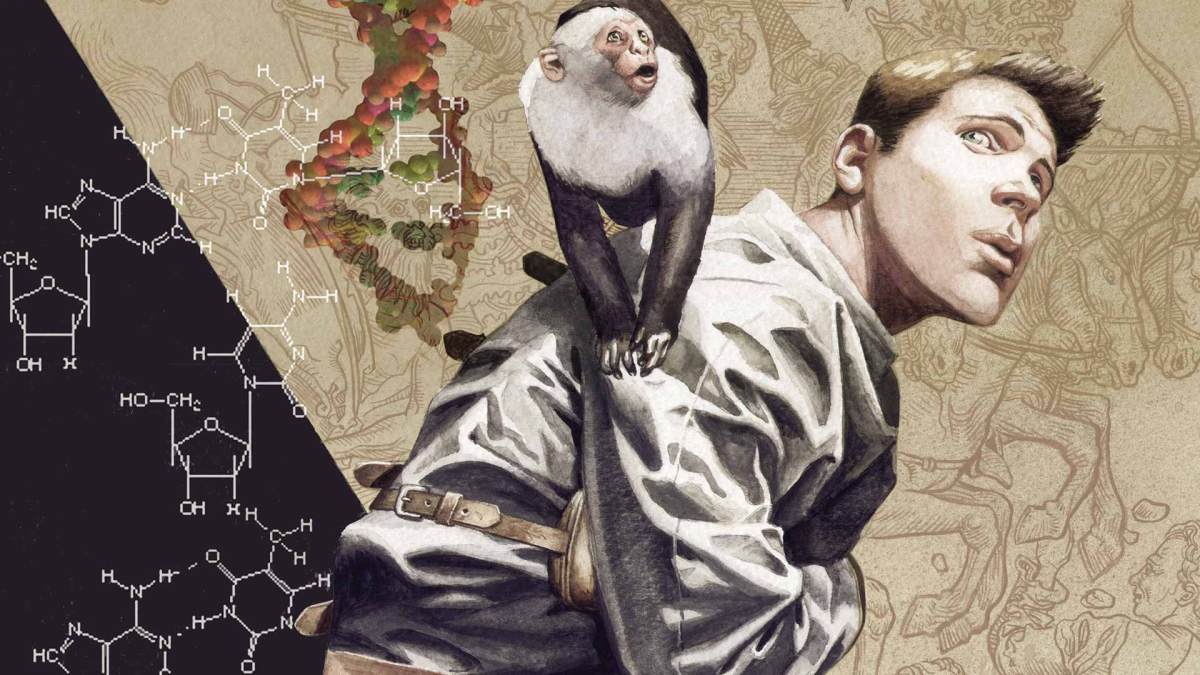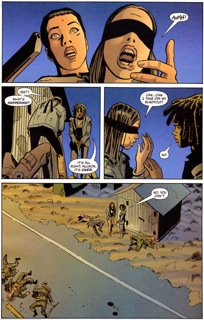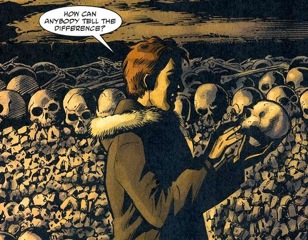In October, The Mary Sue reported that FX is developing a TV series based on the hit graphic novel Y: The Last Man, and there was much rejoicing. Today, we take a look at what all the fuss is about, and what we can look forward to. (Cross-posted from Fiction Unbound.)
On page one of issue one of Y: The Last Man (Vertigo, 2002-2008), the comics epic from Brian K. Vaughan and Pia Guerra, all the men die. A mysterious plague kills every mammal with a Y chromosome, instantly. Three billion bodies later, Woman inherits the earth. Only two men on the entire planet survive: Yorick Brown, a young Brooklyn wiseass, and his monkey, Ampersand. When he makes his way to Washington, the remnants of the U.S. government place him in the care of geneticist Allison Mann and shadowy federal operative Agent 355, to determine why he and Ampersand lived. As they cross the devastated country to Dr. Mann’s San Francisco lab, we watch the nation of surviving women struggle with grief and anarchy, fight, create, rebuild, and remake the country in a new image.
The most readily attractive part of Y: The Last Man—aside from Pia Guerra’s winning artwork—is this soft sci-fi premise played out to ingenious lengths: What does happen when all the men die? For one, airplanes fall out of the sky, because 95% of airline pilots were men. Democrats control both houses of Congress; the Secretary of Agriculture succeeds to the Presidency. Israel, with its gender parity among combat troops, rises as an infantry superpower, and Australia, which allowed women on submarines, rules the seas. The women left in the Vatican scour the world for a virgin birth, hoping for a man they can declare pope, so that pope can declare women able to be ordained.
At its best, the series pits Yorick, 355, and Dr. Mann against women driven to desperate measures out of survival instinct, opportunism, or grief-stricken fanaticism. A sailor ignored in the merchant marine steps up as a heroin smuggler; a pop starlet stranded in Tokyo takes over the remaining Yakuza; a bull-nosed tabloid reporter will kill for printable proof of the rumored last man. In Arizona, the widows of paranoid militia men choke off I-40 in an attempt to topple the feds. In contrast, the women’s prison in Marrisville, Ohio, becomes a stable, peaceful community working together to turn over a new leaf.
Less successful as antagonists are the Daughters of the Amazon, a network of marauders who view the plague as a righteous cleansing of the patriarchy and spout feminist rhetoric as they burn down sperm banks and deface male monuments. The idea of the Amazons—women driven into extremism through grief and starvation, co-opting the language of liberation—has some appeal on paper, but in execution they are just straw feminists, the sort of “misandrists“ dreamed up by GamerGaters, a way for Y: The Last Man to pretend its feminist vision is still moderate.

When your most plausible antagonist is a monkey-hunting ninja named Toyota, it’s time to revisit first principles.
The chief antagonist, Lieutenant-General “Alter” Tse’elon of the Israel Defense Forces, is a similar missed opportunity. Driven to secure Yorick as a strategic advantage for Israel, her belligerence and nationalism become so maniacal that she’s alternately apocalyptic and ridiculous. Ultimately, the series discovers Alter as a figure of deep despair—the hopelessness of a world working together, toward mutual survival—but this interesting characterization comes too late.
The true enemy in Y: The Last Man is that post-9/11 suspicion of civic mortality, the way communities dissolve into paranoia, selfishness, and violence—the worst habits of human thinking—when threatened. This is post-apocalyptic fiction’s constant subject, in a sense. And in this sense, the genre divides into stories in which the triumph of human depravity is assumed—think of the baby-barbecuing cannibals in The Road, or indeed, every story attached to the adjectives “searing” or “unflinching”—and the worlds in which humankind flinches, and resists its own entropy, from the considered preservationism of Canticle for Liebowitz to the magnificent sociological thriller that was the reimagined Battlestar Galactica. Y: The Last Man falls squarely into this latter camp, with a clear-eyed and unsentimental optimism about human competence in the face of catastrophe.
And in this sense, the series’ true hero is not its protagonist Yorick, but Agent 355, Yorick’s relentlessly competent protector. With only the fleetest of backstory, 355 is developed almost entirely by kicking ass in impossibly dangerous situations, and rarely have I seen such a character succeed so completely. 355 is the best of humanity: resourceful, resolute, idealistic—even as she downs enemy after enemy.
It’s that idealism, her vision full of compassion and hope, that makes her deadly determination heroic, while Alter’s rigid, backward determination devolves into insanity.
That 355 should also be a Black woman, serving in a secret executive spy ring with Founding-Fathers pedigree, has a whole additional importance. In retrospect, among the many movements within comics that Y: The Last Man predicted, its genuine diversity is impressive. Women of color like Agent 355 and Allison Mann anticipate popular, groundbreaking superheroes like Kamala Khan; lesbian and trans characters are forerunners of Batwoman and Sera. Most importantly, The Last Man anticipated the apparently revolutionary proposition that women have amazing stories, too—that Spider-Gwen can be as exciting as, if not more so than, Spider-Man.
What else? Well, Yorick gets shut down for mansplaining before it was even a word; President Valentine is arguably taken up and expanded in BSG’s Laura Roslin; the troupe of players in #16-17 anticipate Emily St. John Mandel’s Station Eleven. Pia Guerra’s art is witty, showing an excellent instinct for setting. Vaughan’s script is always above average, often excellent, especially in the final three volumes. Fans frustrated by underwhelming endings of thrilling series (*cough* LOST) will be astonished by how well Yorick’s story wraps up; issue 60 is one of the most moving, perfectly executed endings I’ve seen in any serial medium.
Y: The Last Man is available in collected trade paperbacks. Go ahead and buy the whole damn thing. As apocalypses go, you could do worse than a world without boy bands.
Theodore McCombs is a writer and fake geek guy in Denver. He blogs about speculative literature at Fiction Unbound.
—Please make note of The Mary Sue’s general comment policy.—
Do you follow The Mary Sue on Twitter, Facebook, Tumblr, Pinterest, & Google +?











Published: Dec 18, 2015 03:36 pm